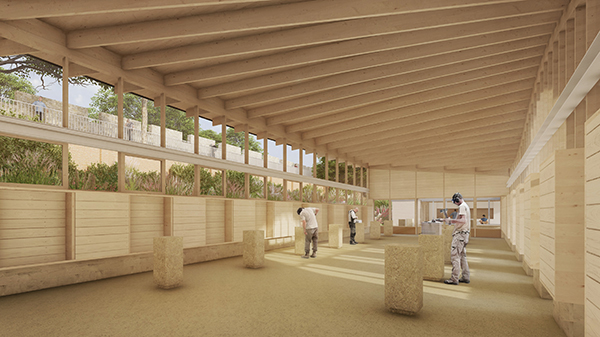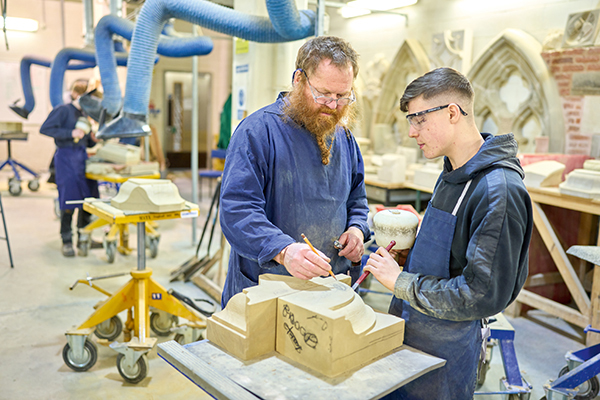Judging by the numbers enrolled at the three colleges involved in delivering the new English Trailblazer apprenticeship in stonemasonry, it is proving popular with the industry.
That’s not altogether surprising as companies from the industry were instrumental in creating the apprenticeship, as the government intended they should be when it came up with the idea of standardising apprenticeships through the Trailblazer scheme.
The idea of putting employers in the driving seat of training was given a further boost in April when the Skills & Post 16 Education Act 2022 (generally referred to as the Skills Act) finally completed its passage through Parliament and received Royal Assent.
The Act introduces new duties on colleges to review and publish how their education and training offer is meeting the skills needs of industry. And the Secretary of State gains new powers to intervene if providers are considered to be failing in this duty.
The government says the idea is to level up opportunities, making it easier for people to train and obtain the skills they need to secure well-paid jobs in industries with skills gaps, which construction consistently says it has and many stone companies complain of.
The Act requires all school pupils to be made aware of the wide range of career options open to them through apprenticeships, T Levels and other training, not just academic routes. And it makes student loans available for higher-level education throughout a person’s life so skills can be upgraded at any age.
Trailblazers
The development of the Trailblazer apprenticeships has been overseen by the Institute of Apprenticeships & Technical Education. Details of the Stonemasonry Trailblazer, with its six routes covering different specialities within the industry, can be viewed on the Institute’s website at bit.ly/StoneTrailblazer.
There are still some grumbles from the colleges about the level of funding the government has allocated (£11,000 a year, although the colleges hope this will be increased when it is reviewed); the fact it is a two-year Level 2 qualification (they wanted it to be a three-year course and say they have ended up with a level two-and-a-half squeezed into two years) and the fact that the final assessment will be carried out at the firms the apprentices work for rather than at the colleges.
The government insisted when it gave itself a monopoly on apprenticeships and set up the Trailblazer scheme that there had to be a final assessment. The original idea was that it should be some kind of exam, but as exams do not suit everyone the stone end-point assessments will take the form of a discussion about what the trainee has learnt and a review of a portfolio they have kept of the work they have carried out.
The aim is to have the final assessments carried out by skilled people from the stone industry familiar with the various routes that can lead to successful completion of the apprenticeship.
Those routes are:
- Heritage Mason
- Façade Preservation
- Exterior Fixer
- Interior Fixer
- Banker Mason
- Memorial Mason
End Point Assessors
The people assessing the apprentices are called End Point Assessors (EPAs). The stone industry is likely to need a fair number of them because stone companies are widely spread around the country. A call by Claire Wallbridge, the Training Officer of the Natural Stone Industry Training Group (NSITG) in May for people willing to take on the role brought forward six people. Anyone else willing to train and take on the role should email Claire on claire@nsitg.org.uk.
In order for the assessments to be fair and equitable, the EPAs will be required to ask the same questions of each student during a discussion element of about an hour. Those questions are currently being formulated. If anyone wants to make suggestions about what should be included, again they should email Claire.
Assessors have to be trained, and are paid during their training, just as they are paid for carrying out the end point assessments, typically over two days, although it is possible for some of the assessment to be carried out by video conference rather than face to face.
How much EPAs are paid depends on how much they have to do, says NOCN, which is the Stonemasonry Trailblazer awarding body that trains, appoints and pays for end point assessors. It does not quote a figure for how much it pays, but considers it generous.
The colleges involved with the Trailblazer apprenticeship in stone are Bath, the Building Crafts College in London, and York. Moulton College in Northamptonshire says it will be joining those offering Trailblazer training, but has not yet done so as this is written. The websites of the colleges are listed right, along with some other websites that might be useful.
The colleges are so far offering only some of the routes to the Stonemasonry Trailblazer. The Memorial Masonry route presents particular challenges for colleges, but the National Association of Memorial Masons (NAMM) might be able to develop this route itself.
Another requirement the government has placed on apprenticeships is that apart from the knowledge, skills and behaviour (KSB) requirements of the job, anyone who has not obtained English and maths qualifications at school will have to achieve a Level 2 qualification in the subjects during their apprenticeships.
For those with an education, health and care plan or a legacy statement, the apprenticeship’s English and maths minimum requirement is Entry Level 3.
Without English and maths, apprentices will not be able to enter what is called Gateway, which comes at the end of the apprenticeship and means the apprentice is considered ready for their end point assessments.
The assessments will determine whether the apprentice fails, passes or gains a distinction in their Apprenticeship. Sharon Street of NOCN says: “We’re not going out to fail anyone. We want to get to Distinction if we can.”
If an apprentice fails any part of the assessment, they will be able to retake just that part as long as they do so within three months. If they are not ready within three months, they will have to re-take the whole assessment – and the assessments have to be paid for by the company if the apprentice fails.
In Scotland, Wales and Northern Ireland, the apprenticeships are different. In Scotland you can obtain a Foundation Apprenticeship at school that can lead on to a Modern Apprenticeship and possibly higher education and a Graduate Apprenticeship. There’s a lot of useful information on www.apprenticeships.scot.
Wales also has various levels of apprenticeship, again starting with a Foundation Apprenticeship, then an Apprenticeship, then a Higher Apprenticeship and up to a Degree Apprenticeship. There’s more information on careerswales.gov.wales/apprenticeships.
In Northern Ireland apprenticeships are available at Levels 2, 3 and Higher Level Apprenticeships (Level 4 and above). There are Level 2 and Level 3 apprenticeships in stonemasonry available. Information can be found at www.nidirect.gov.uk/articles/occupational-profile-stone-masonry.
There is a cost involved in training people, although firms registered with CITB, whether or not they actually pay a levy, receive a grant (currently £2,500 a year) for each apprentice, plus £3,500 when an apprentice successfully completes an apprenticeship.
Other routes to training
Although the long-awaited Trailblazer apprenticeship has unblocked a log-jam of training caused by firms waiting for it to be adopted, apprenticeships are far from the only training route available. The colleges themselves, as well as a range of other training providers, offer courses leading to certificates, diplomas and NVQs.
Among the alternatives are those offered by Priestman Associates LLP, which has been a trusted trainer in stonemasonry for decades, helping to qualify the workforce. Mark Priestman, one of the partners, writes this magazine’s regular Training column and his father, David Priestman, was influential in the development of many of the qualifications available to the stone industry’s workforce.
Priestman Associates provides:
- Short courses in conservation, heritage skills, facade preservation, stonemasonry and contracts supervision, and leadership. As a CITB Approved Training Organisation, Priestman Associates’ courses attract an attendance grant for CITB registered employers
- CITB Specialist Applied-Skills Programmes (SAPs) in Level 2 Stone Fixing (exterior and interior) and Level 2 Façade Preservation (stone cleaning and restoring)
Priestman Associates provides employers with a route to qualifying their workforces by combining work-based mentoring, off-site training (20 days spread over a year to minimise disruption) and NVQ Level 2 assessment.
Both programmes are fee neutral to CITB registered companies.
CITB SAP in Level 3 Heritage Stonemasonry. Priestman Associates has specifically been supported by the Natural Stone Industry Training Group (NSITG) and Stone Federation GB in both its tender and delivery of this SAP
This programme is again fee-neutral for CITB employers. Learners must be employed for the duration of the programme and their employer must mentor them so they can produce a portfolio of evidence for the Level 3 NVQ in Heritage Construction Skills Mason.
Priestman Associates can support this programme throughout the four nations of the UK if interest is sufficient.
On-site assessment
On-site assessment is popular among experienced workers needing an NVQ to obtain a CSCS card appropriate to their level of skill. On-site assessment consists of the learner building a portfolio of competency, undertaking a recorded professional discussion and being observed at work.
Priestman Associates offers the following on-site assessments:
Level 6 NVQ, suitable for black CSCS Manager card applicants, in:
- Construction Site Management: Building & Civil Engineering
- Construction Site Management: Conservation
- Construction Contracting Management
- Level 3 NVQ, suitable for gold CSCS Supervisor card applicants:
- Construction Contracting Operations General
- Occupational Work Supervision Construction
Level 3 NVQ, for gold CSCS Advanced Worker card applicants:
- Banker Mason
- Heritage Skills Facade Preservation
- Heritage Skills Mason
Level 2 NVQ, for blue CSCS SkilledWorker card applicants:
- Mason: Banker
- Mason: Cladder
- Mason: Cutter
- Mason: External Stone Fixer
- Mason: Internal Stone Fixer
- Facade Preservation: Cleaner
- Facade Preservation: Restorer
- Modular Pavement Instalment
Anyone who registers on a construction NVQ can apply for a red CSCS Trainee Card so they can get access to sites for the work covered by their NVQ.
Priestman Associates also offers training for using dichloromethane (DCM)-based paint stripper. It is illegal in the UK to buy or use DCM-based paint stripper unless the purchaser and user holds a Health & Safety Executive (HSE) certificate of competency, obtained by taking a one-day course followed by an HSE online test.
Contacts for Priestman Associates LLP
- David Priestman david@priestmanweb.com 07943 641586
- Mark Priestman mark@priestmanweb.com 07876687212
Some useful stonemasonry training websites...
Natural Stone Industry Training Group
www.nsitg.org.uk
Colleges
Building Crafts College
www.thebcc.ac.uk
City of Bath College
www.citybathcoll.ac.uk
City & Guilds of London Art School
www.cityandguildsartschool.ac.uk
Elgin Stonemasonry Training Facility
www.historicenvironment.scot
Moulton College
www.moulton.ac.uk
West Dean College
www.westdean.org.uk
York College
www.yorkcollege.ac.uk
And others
Building Limes Forum
www.buildinglimesforum.org.uk
Cathedrals Workshop Fellowship
cwfcathedrals.co.uk
CITB
www.citb.co.uk
Dry Stone Walling Association
www.dswa.org.uk
Go Construct
www.goconstruct.org
Lettering Arts Trust
www.letteringartstrust.org.uk
National Association of Memorial Masons
www.namm.org.uk
Natural Stone Directory
www.stonespecialist.com
trade-services/training
Priestman Associates
www.priestmanweb.com
Scottish Lime Centre
www.scotlime.org
The Prince’s Foundation
princes-foundation.org
Society for the Protection of Ancient Buildings (SPAB)
www.spab.org.uk
Queen Elizabeth Scholarship Trust (QEST)
www.qest.org.uk
Worshipful Company of Masons
www.masonslivery.org
York Consortium for Conservation & Craftsmanship
www.conservationyork.org.uk
York Minster aims for excellence

York Minster is one of England’s 10 cathedrals with their own stonemasonry department. The 10 cathedrals work together on training through the organisation they have established called the Cathedral Workshops Fellowship, although its foundation degree course is now also open to masons working outside of the cathedral network. And now, York Minster plans to develop and extend its own craft skills training facilities by creating a world class campus for research, education and training in craft skills on the Minster’s 15-acre site.
This Centre of Excellence for Heritage Craft Skills & Estate Management came a step closer following a community referendum of residents in the Minster Precinct Neighbourhood Area, which showed a majority in favour of the Minster’s proposed £5million fully funded project that is being co-ordinated by the York Minster Fund.
As well as the training centre, the project includes new visitor facilities, a new public square, enhanced public realm and green spaces, and a discovery and learning centre and museum.
Following the referendum, the Minster’s neighbourhood plan is being adopted by City of York Council as part of the statutory development plan for the city, and a planning application has been submitted for the work in the Minster Precinct to progress. A decision is expected before the end of the summer and, if consented, the work is expected to be completed in 2024.
The scheme, designed by the architectural practice Tonkin Liu, will provide new facilities for craftspeople, including York Minster’s stonemasons, and house and deliver training in modern techniques and processes to apprentices and students in York and further afield, working with cutting edge digital facilities alongside the ancient craft skills for which the Minster’s stoneyard is renowned.
Existing buildings within the Precinct will be re-ordered, re-purposed and renewed to provide new workspaces and associated facilities, enable greater engagement and interaction with the public around key crafts and trades, and facilitate improved links with education. The Centre of Excellence for Heritage Craft Skills & Estate Management will bring benefits including continuing the craft of stonemasonry and encouraging global learning and knowledge sharing, as well as being a shining example of best practice in managing complex heritage estates.
The vision for the Centre of Excellence is a key element of a plan that sets out a policy-led approach to creating a sustainable future for the Minster and its estate.
Alex McCallion, Director of Works and Precinct at York Minster, says: “It takes a multidisciplinary team of skilled heritage craftspeople and experts in their field to maintain and care for the ongoing cycle of repair, restoration, conservation and development of York Minster, its ancient buildings and monuments. Our existing stoneyard houses the complete range of craft and trade skills that are vital to achieve this.
“Yet despite this, the facilities available to our skilled workforce are constrained and inadequate, set against a backdrop of declining craft skills. We also recognise the need to keep pace with innovations and modern processes such as digital technology, data scanning and computer-aided design (CAD).
“The creation of a Centre of Excellence for Heritage Craft Skills & Estate Management will, therefore, not only enable the preservation and development of the ancient craft skills that have sustained the Minster over the centuries, it will also secure the long-term environmental, financial and heritage sustainability of it for future generations to enjoy as we do today.
“It will position York Minster as leading the charge for the preservation of ancient craft skills on the international stage, facilitating knowledge sharing and exchange programmes with partner cathedrals worldwide, including Washington, Milan and Trondheim, and will also have immediate economic and tourism benefits for York and the wider region.”

Scholarships and bursaries
There are routes to training that provide financial support and can be beneficial as a status throughout a person’s career.
The Prince’s Foundation Building Crafts Programme, for example, is a fully funded eight-month course with a full scholarship covering the course fees and a monthly bursary of £1,000 to cover travel and living costs.
The Society for the Protection of Ancient Buildings (SPAB) offers three or four William Morris Craft Fellowship places each year. There are no course fees and Fellows receive a bursary of £6,500 to cover basic travel and living costs. The York Consortium for Conservation & Craftsmanship also provides support to Fellows on application.
Both the above are for those who already have skills and want to progress them.
The Queen Elizabeth Scholarship Trust (QEST) does not provide the training but offers to fund those who can make a convincing enough application for a bursary. Again, this is to help those who have already been through basic training to advance their skills. QEST continues to support its Scholars throughout their careers. It is often approached to invite its Scholars to contribute to other endeavours, such as the John Smedley Craft Prize won by Zoë Wilson, pictured below. The Prize, worth £15,000, was open to QEST Scholars only.
Another source of bursaries for stonemasonry students is the Masons’ Livery Company, the Worshipful Company of Masons. It supports trainers, including those just starting out on a career in stonemasonry, through its Craft Fund charity. It has just released a video about the charity, which you can watch at bit.ly/WCMcraft.

It is a seven-episode prime-time reality series fronted by Jim Moir (Vic Reeves) featuring six different crafts. It started on 18 May at 8pm and Zoë’s contribution, with her student Charlie Gee, was aired on 15 June.
The final episode will see the crafters from the previous episodes, including Charlie Gee, visit Dumfries House, in East Ayrshire, home to The Prince’s Foundation, before taking part in a graduation that involves presenting their work to His Royal Highness Prince Charles at his home, Highgrove House.
All the work produced during the series will then be displayed at the new training base of The Prince’s Foundation at Highgrove.
Zoë says she did not get to meet the Prince, although she enjoyed meeting Jim Moir.
The TV appearance came about through Instagram. One of Zoë’s 77,000 followers drew her attention to an advertisement calling for craftspeople to apply to take part. So she applied – and admits she was excited to be included.
It could even be the start of a new career as there is now talk of another TV appearance. And Zoë admits she would encompass it enthusiastically “as long as I can continue to carve stone”.
Her TV appearance follows her success as the winner of the inaugural John Smedley Craft Prize, that meant some of her work was exhibited and went on sale at the John Smedley store in Jermyn Street, London, as part of this year’s London Craft Week (9-15 May).
John Smedley promotes itself as ‘the world’s finest knitwear clothing brand’. It regularly takes part in London Craft Week and this year approached Queen Elizabeth Scholarship Trust (QEST) to ask it to invite its Scholars to present works for the new John Smedley Craft Prize.
Zoë became a QEST Scholar after being supported by QEST during her study of stone carving at the City & Guilds of London Art School.
The whole John Smedley prize is worth £15,000, including £5,000 in cash and a £5,000 commission from John Smedley, as well as exhibitions in the John Smedley store in London and, later in the year, in a new store the company is opening in Kyoto, Japan.
There were plenty of QEST Scholars bidding for the John Smedley Craft Prize, from which five involved in various crafts were shortlisted. Their work was shown on the internet and the public was invited to vote, which about 8,000 did. The result was close, but the winner was Zoë. Her work in the exhibition included original works in British stones – Welsh Slate, Corsehill sandstone and Portland limestone – as well as casts in Jesmonite.
The commission from John Smedley will involve the geometric patterns that are a hallmark of Zoë’s work being produced as coasters or place mats, with Zoë’s designs reproduced on Lincolnshire limestone by a CNC at Cranbourne Stone of Stockbridge, Hampshire. John Smedley will package the items and sell them from its stores.

